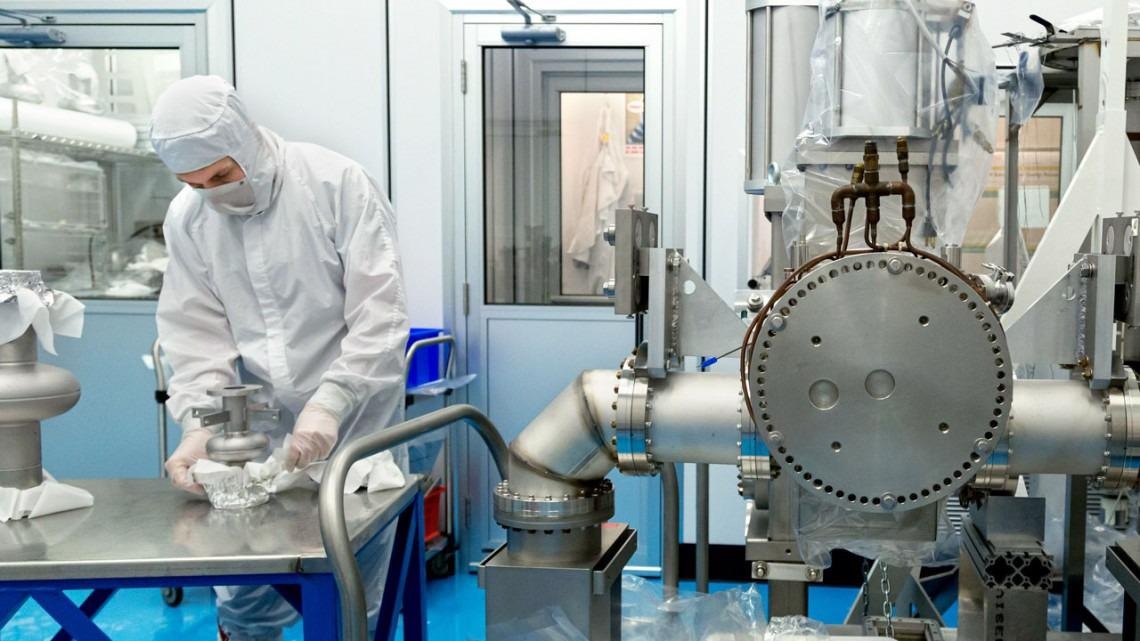Reviewed by Alex SmithSep 21 2021
An award of $22.5 million from the National Science Foundation (NSF) has been given to a partnership of scientists led by Cornell University to advance the core understanding needed to transform the brightness of electron beams available to medicine, science and industry.
 Cornell doctoral student Ryan Porter prepares a superconducting radio-frequency cavity made from the element Nb3Sn in the cleanroom of Newman Lab. Image Credit: Cornell University.
Cornell doctoral student Ryan Porter prepares a superconducting radio-frequency cavity made from the element Nb3Sn in the cleanroom of Newman Lab. Image Credit: Cornell University.
In November 2016, the Center for Bright Beams (CBB), an NSF Science and Technology Center, was created with a preliminary $23 million award to Cornell and partner institutions. The center incorporates accelerator science with condensed matter physics, surface science and materials science for the progress of particle accelerator technologies.
These insights will help enhance the performance and lower the cost of accelerator technologies worldwide and develop new research tools that revolutionize the frontiers of materials science, biology, particle physics, condensed matter physics and nuclear physics, as well as new manufacturing tools that allow chip manufacturers to continue miniaturizing the features of integrated circuits.
Currently, all of these scientific and industrial instruments are limited by the brightness of their beams. CBB is the only center in the world that brings together an interdisciplinary approach to address critical challenges limiting accelerator science. This renewed funding will help us build on our successes to date, which have benefited enormously from our collaborative approach.
Ritchie Patterson, Director, Center for Bright Beams
Patterson is also the Helen T. Edwards Professor of Physics in the College of Arts and Sciences.
The center is located at Cornell’s Laboratory for Accelerator-based ScienceS and Education (CLASSE) and includes researchers from Cornell’s Departments of Physics, Applied and Engineering Physics, and Chemistry and Chemical Biology, as well as researchers from seven other universities and three national laboratories.
CBB comprises three interdependent research themes linked to acceleration, beam production and dynamics and control. These themes unite to focus on the formation of smaller, brighter electron beams.
Since 2016, CBB’s efforts have produced an electron source that is 10 times smaller in size and divergence than typical sources currently in use. This will pave the way for drug design by enabling biologists who study the dynamics and structure of single molecules to decrease their data collection time by 90%.
The center has also formulated new approaches for beam acceleration that possess the same performance as today’s beam accelerators but are incredibly simpler to operate. CBB’s high-field Superconducting Radio Frequency (SRF) cavities will diminish the construction costs of the biggest accelerators by up to billions of dollars by decreasing the number of cavities and the length of tunnels.
Relaxed operating temperatures of cavities will shorten cryogenics, making beams readily accessible to industry and universities, or “a beam in every basement.”
There are approximately 30,000 medical and industrial accelerators currently in use, with yearly sales of $3.5 billion. David Muller, CBB’s director of knowledge transfer in Phase I, and the Samuel B. Eckert Professor of Engineering in the School of Applied and Engineering Physics said the center’s research intends to increase that number since brighter beams facilitate new capabilities.
With this new round of funding, CBB will pursue the most productive research to achieve even higher brightness, and we will ready these methods for accelerators being used by chip manufacturers and industrial leaders, as well as smaller research institutions.
David Muller, Director of Knowledge Transfer in Phase I, Center for Bright Beams
For over a century, massive advances in chemistry, physics and biology have resulted from scattering, spectroscopy, imaging and colliding beam experiments.
To see something new, one must do something new, and these experiments are presently becoming progressively dependent on time-resolved data, which allows for such things as true movies of molecular machines operating.
Examples of other innovative approaches that rely on the progress of particle beams include beams for tumor treatment, instruments for wafer metrology, electron microscopes equipped to image individual atoms and the Large Hadron Collider.
While CBB carries on making key advances in the particle accelerator frontier, its greatest influence may be the outcome of educating future researchers in electron beam technology.
These large-scale colliders, intense X-ray sources, and electron microscopes are essential tools for science and industry, but the U.S. educates few students to understand the bright electron beams on which they depend for success.
Melissa Hines, Associate Director, Center for Bright Beams
Melissa Hines is also a Professor of Chemistry at A&S.
Our graduate students are helping to bridge this gap, and approximately half of CBB’s students are in areas that the Department of Energy has identified as areas of critical need. Our most important output is almost certainly going to be the large number of graduate students and postdocs, most of whom will go off to have a big impact in a variety of different fields.
Melissa Hines, Associate Director, Center for Bright Beams
CBB also includes Brigham Young University; Fermi National Accelerator Laboratory; University of California, Los Angeles; Arizona State University; University of Chicago; University of Florida; University of New Mexico; Northern Illinois University; Lawrence Berkeley National Laboratory; and SLAC National Accelerator Laboratory and affiliates at other institutions.
The NSF Science and Technology Centers: Integrative Partnerships program supports groundbreaking, possibly transformative research and education projects that necessitate large-scale, long-term awards. The centers nurture pioneering research, education of the next generations of researchers and wide distribution of the knowledge and technology created.